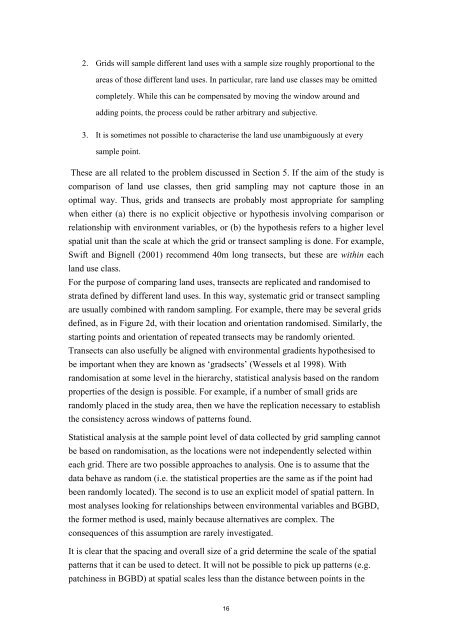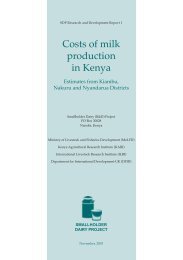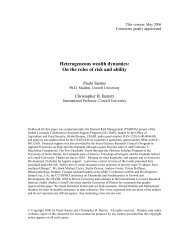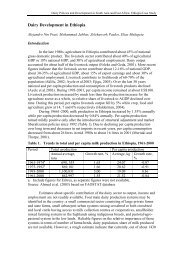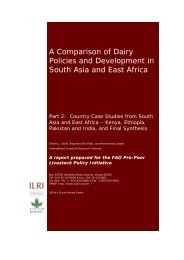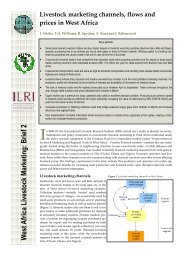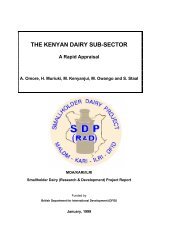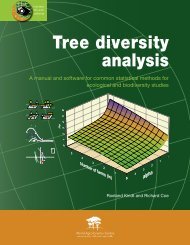Designing ecological and biodiversity sampling strategies
Designing ecological and biodiversity sampling strategies
Designing ecological and biodiversity sampling strategies
Create successful ePaper yourself
Turn your PDF publications into a flip-book with our unique Google optimized e-Paper software.
2. Grids will sample different l<strong>and</strong> uses with a sample size roughly proportional to theareas of those different l<strong>and</strong> uses. In particular, rare l<strong>and</strong> use classes may be omittedcompletely. While this can be compensated by moving the window around <strong>and</strong>adding points, the process could be rather arbitrary <strong>and</strong> subjective.3. It is sometimes not possible to characterise the l<strong>and</strong> use unambiguously at everysample point.These are all related to the problem discussed in Section 5. If the aim of the study iscomparison of l<strong>and</strong> use classes, then grid <strong>sampling</strong> may not capture those in anoptimal way. Thus, grids <strong>and</strong> transects are probably most appropriate for <strong>sampling</strong>when either (a) there is no explicit objective or hypothesis involving comparison orrelationship with environment variables, or (b) the hypothesis refers to a higher levelspatial unit than the scale at which the grid or transect <strong>sampling</strong> is done. For example,Swift <strong>and</strong> Bignell (2001) recommend 40m long transects, but these are within eachl<strong>and</strong> use class.For the purpose of comparing l<strong>and</strong> uses, transects are replicated <strong>and</strong> r<strong>and</strong>omised tostrata defined by different l<strong>and</strong> uses. In this way, systematic grid or transect <strong>sampling</strong>are usually combined with r<strong>and</strong>om <strong>sampling</strong>. For example, there may be several gridsdefined, as in Figure 2d, with their location <strong>and</strong> orientation r<strong>and</strong>omised. Similarly, thestarting points <strong>and</strong> orientation of repeated transects may be r<strong>and</strong>omly oriented.Transects can also usefully be aligned with environmental gradients hypothesised tobe important when they are known as ‘gradsects’ (Wessels et al 1998). Withr<strong>and</strong>omisation at some level in the hierarchy, statistical analysis based on the r<strong>and</strong>omproperties of the design is possible. For example, if a number of small grids arer<strong>and</strong>omly placed in the study area, then we have the replication necessary to establishthe consistency across windows of patterns found.Statistical analysis at the sample point level of data collected by grid <strong>sampling</strong> cannotbe based on r<strong>and</strong>omisation, as the locations were not independently selected withineach grid. There are two possible approaches to analysis. One is to assume that thedata behave as r<strong>and</strong>om (i.e. the statistical properties are the same as if the point hadbeen r<strong>and</strong>omly located). The second is to use an explicit model of spatial pattern. Inmost analyses looking for relationships between environmental variables <strong>and</strong> BGBD,the former method is used, mainly because alternatives are complex. Theconsequences of this assumption are rarely investigated.It is clear that the spacing <strong>and</strong> overall size of a grid determine the scale of the spatialpatterns that it can be used to detect. It will not be possible to pick up patterns (e.g.patchiness in BGBD) at spatial scales less than the distance between points in the16


